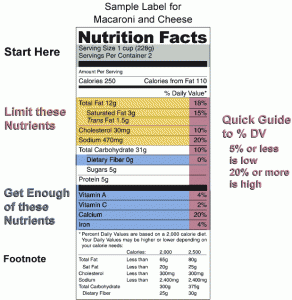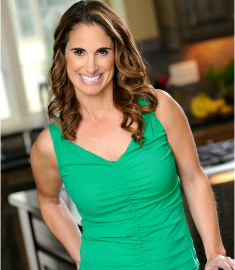 Most of us find it a daunting task just to understand nutrition facts while choosing healthy foods. All those numbers and serving sizes, ugh! We have to remember that the size of the serving listed on the food package may not necessarily be the amount that we’re going to eat. Sometimes, the amount is way too much but more often, the portion is less than we expected.
Most of us find it a daunting task just to understand nutrition facts while choosing healthy foods. All those numbers and serving sizes, ugh! We have to remember that the size of the serving listed on the food package may not necessarily be the amount that we’re going to eat. Sometimes, the amount is way too much but more often, the portion is less than we expected.
Before we get into how to understand food labels, several portion tips to remember: one teaspoon of fat (45 calories) is about the size of a poker chip; 1 ½ ounce (125 calories) of cheese is about the size of 4 dice; One cup of whole wheat pasta or brown rice is about the size of a baseball.
Basically, when we’re checking out nutrition facts, one question we should ask ourselves is “how many servings am I eating?”. Remember to pay attention to the serving size and the amount of servings in the food package. For example, if one serving equals one cup and there are four servings in the whole package, you would be eating four cups if you ate the whole package – in essence, quadrupling the calories and the amounts of all other nutrients!
Tips to reading and understanding food labels:
- Check calories: The number of servings you consume basically determines the amount of calories you actually eat. The percentage of fat should also be listed on the same line. However, a more useful tip would be to check what types of fat are contained in the package and how much of them there are (Tip #2).
- Check type and amount of fat: Consuming too much saturated fat and cholesterol can increase one’s risk of certain chronic diseases, such as, diabetes, heart disease, cancer and obesity. You should keep in mind that the number of servings you consume determines the amount of fat you actually eat. While saturated fat and trans fat are listed separately, they are still included in the total amount of fat.
- Check for fiber and sugar: You should look for foods that are high in fiber and low in sugar. A good goal for fiber would be 24-32 grams per day.
- Check for sodium: According to the U.S. Dietary Guidelines, sodium intake should be limited to around 2,300mg/day. Most processed foods are very high in sodium.
Assistance provided by Rachel Yam






